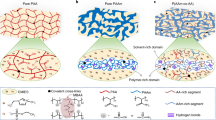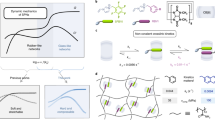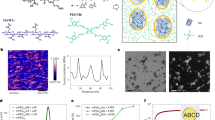Abstract
Consecutive mechanical loading cycles cause irreversible fatigue damage and residual strain in gels, affecting their service life and application scope. Hysteresis-free hydrogels within a limited deformation range have been created by various strategies. However, large deformation and high elasticity are inherently contradictory attributes. Here we present a nanoconfined polymerization strategy for producing tough and near-zero-hysteresis gels under a large range of deformations. Gels are prepared through in situ polymerization within nanochannels of covalent organic frameworks or molecular sieves. The nanochannel confinement and strong hydrogen bonding interactions with polymer segments are crucial for achieving rapid self-reinforcement. The rigid nanostructures relieve the stress concentration at the crack tips and prevent crack propagation, enhancing the ultimate fracture strain (17,580 ± 308%), toughness (87.7 ± 2.3 MJ m−3) and crack propagation strain (5,800%) of the gels. This approach provides a general strategy for synthesizing gels that overcome the traditional trade-offs of large deformation and high elasticity.
This is a preview of subscription content, access via your institution
Access options
Access Nature and 54 other Nature Portfolio journals
Get Nature+, our best-value online-access subscription
$29.99 / 30 days
cancel any time
Subscribe to this journal
Receive 12 print issues and online access
$259.00 per year
only $21.58 per issue
Buy this article
- Purchase on Springer Link
- Instant access to full article PDF
Prices may be subject to local taxes which are calculated during checkout





Similar content being viewed by others
Data availability
The data that support the findings of this study are available within the article and its Supplementary Information. The other relevant data are available at https://doi.org/10.5281/zenodo.8347583. Source data are provided with this paper.
References
Dobashi, Y. et al. Piezoionic mechanoreceptors: force-induced current generation in hydrogels. Science 376, 502–507 (2022).
Na, H. et al. Hydrogel-based strong and fast actuators by electroosmotic turgor pressure. Science 376, 301–307 (2022).
Kirtane, A. R. et al. Development of oil-based gels as versatile drug delivery systems for pediatric applications. Sci. Adv. 8, eabm8478 (2022).
Griffin, D. R. et al. Activating an adaptive immune response from a hydrogel scaffold imparts regenerative wound healing. Nat. Mater. 20, 560–569 (2021).
Guo, J. L. et al. Modular, tissue-specific, and biodegradable hydrogel cross-linkers for tissue engineering. Sci. Adv. 5, eaaw7396 (2019).
Christianson, C., Goldberg, N. N., Deheyn, D. D., Cai, S. & Tolley, M. T. Translucent soft robots driven by frameless fluid electrode dielectric elastomer actuators. Sci. Robot. 3, eaat1893 (2018).
Liu, C. et al. Tough hydrogels with rapid self-reinforcement. Science 372, 1078–1081 (2021).
Kim, J., Zhang, G., Shi, M. & Suo, Z. Fracture, fatigue, and friction of polymers in which entanglements greatly outnumber cross-links. Science 374, 212–216 (2021).
Wang, Z. et al. Toughening hydrogels through force-triggered chemical reactions that lengthen polymer strands. Science 374, 193–196 (2021).
Gong, J. P., Katsuyama, Y., Kurokawa, T. & Osada, Y. Double-network hydrogels with extremely high mechanical strength. Adv. Mater. 15, 1155–1158 (2003).
Jiang, Z. et al. Strong, self-healable, and recyclable visible-light-responsive hydrogel actuators. Angew. Chem. Int. Ed. 59, 7049–7056 (2020).
Haraguchi, K. & Takehisa, T. Nanocomposite hydrogels: a unique organic–inorganic network structure with extraordinary mechanical, optical, and swelling/de-swelling properties. Adv. Mater. 14, 1120–1124 (2002).
Li, J., Suo, Z. & Vlassak, J. J. Stiff, strong, and tough hydrogels with good chemical stability. J. Mater. Chem. B 2, 6708–6713 (2014).
Meng, X. et al. Hysteresis-free nanoparticle-reinforced hydrogels. Adv. Mater. 34, 2108243 (2022).
Chen, Q. et al. A novel design strategy for fully physically linked double network hydrogels with tough, fatigue resistant, and self-healing properties. Adv. Funct. Mater. 25, 1598–1607 (2015).
Zhang, H. J. et al. Tough physical double-network hydrogels based on amphiphilic triblock copolymers. Adv. Mater. 28, 4884–4890 (2016).
Xia, L.-W. et al. Nano-structured smart hydrogels with rapid response and high elasticity. Nat. Commun. 4, 2226 (2013).
Hu, J. et al. Microgel-reinforced hydrogel films with high mechanical strength and their visible mesoscale fracture structure. Macromolecules 44, 7775–7781 (2011).
Lei, H. et al. Stretchable hydrogels with low hysteresis and anti-fatigue fracture based on polyprotein cross-linkers. Nat. Commun. 11, 4032 (2020).
Fujiyabu, T. et al. Tri-branched gels: rubbery materials with the lowest branching factor approach the ideal elastic limit. Sci. Adv. 8, eabk0010 (2022).
Hua, M. et al. Strong tough hydrogels via the synergy of freeze-casting and salting out. Nature 590, 594–599 (2021).
Li, W. et al. Supramolecular ionogels tougher than metals. Adv. Mater. 35, 2301383 (2023).
Zhuo, Y. et al. Simultaneously toughening and stiffening elastomers with octuple hydrogen bonding. Adv. Mater. 33, 2008523 (2021).
Liang, X. et al. Anisotropically fatigue-resistant hydrogels. Adv. Mater. 33, 2102011 (2021).
Xiang, C. et al. Stretchable and fatigue-resistant materials. Mater. Today 34, 7–16 (2020).
Liang, X. et al. Bioinspired 2D isotropically fatigue-resistant hydrogels. Adv. Mater. 34, 2107106 (2022).
Biswal, B. P. et al. Mechanochemical synthesis of chemically stable isoreticular covalent organic frameworks. J. Am. Chem. Soc. 135, 5328–5331 (2013).
Chandra, S. et al. Chemically stable multilayered covalent organic nanosheets from covalent organic frameworks via mechanical delamination. J. Am. Chem. Soc. 135, 17853–17861 (2013).
Lu, Y. et al. Self-recovery, fatigue-resistant, and multifunctional sensor assembled by a nanocellulose/carbon nanotube nanocomplex-mediated hydrogel. ACS Appl. Mater. Interfaces 13, 50281–50297 (2021).
Sun, X. et al. Carbon nanotubes reinforced hydrogel as flexible strain sensor with high stretchability and mechanically toughness. Chem. Eng. J. 382, 122832 (2020).
Hu, Y. et al. Graphene oxide encapsulating liquid metal to toughen hydrogel. Adv. Funct. Mater. 31, 2106761 (2021).
Xia, Q. et al. Metal–organic framework (MOF) facilitated highly stretchable and fatigue-resistant ionogels for recyclable sensors. Mater. Horizons 9, 2881–2892 (2022).
Huang, Y. et al. A self-healable and highly stretchable supercapacitor based on a dual crosslinked polyelectrolyte. Nat. Commun. 6, 10310 (2015).
Li, Y., Yan, J., Liu, Y. & Xie, X.-M. Super tough and intelligent multibond network physical hydrogels facilitated by Ti3C2Tx MXene nanosheets. ACS Nano 16, 1567–1577 (2022).
Norioka, C., Inamoto, Y., Hajime, C., Kawamura, A. & Miyata, T. A universal method to easily design tough and stretchable hydrogels. NPG Asia Mater. 13, 34 (2021).
Li, W. et al. Recyclable, healable, and tough ionogels insensitive to crack propagation. Adv. Mater. 34, 2203049 (2022).
Zheng, Y. et al. Nanophase separation in immiscible double network elastomers induces synergetic strengthening, toughening, and fatigue resistance. Chem. Mater. 33, 3321–3334 (2021).
Yang, Y., Wang, X., Yang, F., Shen, H. & Wu, D. A universal soaking strategy to convert composite hydrogels into extremely tough and rapidly recoverable double-network hydrogels. Adv. Mater. 28, 7178–7184 (2016).
Wang, Y. J. et al. Ultrastiff and tough supramolecular hydrogels with a dense and robust hydrogen bond network. Chem. Mater. 31, 1430–1440 (2019).
Li, W. et al. Tough hydrogels with isotropic and unprecedented crack propagation resistance. Adv. Funct. Mater. 32, 2207348 (2022).
Zhao, X. et al. Soft materials by design: unconventional polymer networks give extreme properties. Chem. Rev. 121, 4309–4372 (2021).
Acknowledgements
This work was supported by the National Natural Science Foundation of China (21835005, F.Y.; 52333002, F.Y.), Jiangsu Province Science Foundation for Carbon Emissions Peak and Carbon Neutrality Science and Technology Innovation (BK20220007, F.Y.), Postgraduate Research & Practice Innovation Program of Jiangsu Province (KYCX22_3202, W.L.), Collaborative Innovation Center of Suzhou Nano Science and Technology and Priority Academic Program Development of Jiangsu Higher Education Institutions. We are grateful to Q. Zhang for the technical support with the SAXS measurement with the Vacuum Interconnected Nanotech Workstation (Nano-X) from Suzhou Institute of Nano-Tech and Nano-Bionics, Chinese Academy of Sciences.
Author information
Authors and Affiliations
Contributions
W.L. and F.Y. conceived the concept. F.Y. supervised the project. W.L. conducted the experiments. W.L. and F.Y. wrote the manuscript. X.W., Z.L., Z.S., D.L., L.L., Y.G. and X.Z. participated in optimizing the figures and assisted with material fabrication and characterization. All the authors contributed to the analysis and discussion of the data.
Corresponding author
Ethics declarations
Competing interests
The authors declare no competing interests.
Peer review
Peer review information
Nature Materials thanks Michael Dickey and the other, anonymous, reviewer(s) for their contribution to the peer review of this work.
Additional information
Publisher’s note Springer Nature remains neutral with regard to jurisdictional claims in published maps and institutional affiliations.
Supplementary information
Supplementary Information
Supplementary Figs. 1–34 and Discussion.
Source data
Source Data Fig. 2
Statistical source data.
Source Data Fig. 3
Statistical source data.
Source Data Fig. 3
Unprocessed gels.
Source Data Fig. 4
Statistical source data.
Source Data Fig. 5
Statistical source data.
Source Data Fig. 5
Unprocessed two-dimensional SAXS image and unprocessed molecular dynamics simulation snapshots.
Rights and permissions
Springer Nature or its licensor (e.g. a society or other partner) holds exclusive rights to this article under a publishing agreement with the author(s) or other rightsholder(s); author self-archiving of the accepted manuscript version of this article is solely governed by the terms of such publishing agreement and applicable law.
About this article
Cite this article
Li, W., Wang, X., Liu, Z. et al. Nanoconfined polymerization limits crack propagation in hysteresis-free gels. Nat. Mater. 23, 131–138 (2024). https://doi.org/10.1038/s41563-023-01697-9
Received:
Accepted:
Published:
Issue Date:
DOI: https://doi.org/10.1038/s41563-023-01697-9
This article is cited by
-
Tear-resistant stretchy gels
Nature Materials (2024)
-
Advanced construction strategies to obtain nanocomposite hydrogels for bone repair and regeneration
NPG Asia Materials (2024)
-
Fatigue-resistant Hydrogels
Chemical Research in Chinese Universities (2024)



